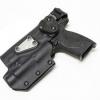This guy says it well I think. GeodkytMay 3, 2013 at 12:51 PMThe technical meaning of "arms" in teh Eighteenth Century was individual weapons and equipment for combat service. For example, "a stand of arms" (the basis under which colonels were required to equip their regiments, under the privage patronage regimental system britain used shortly before the Revolution) was the weapons AND EQUIPMENT considered necessary to equip one soldier for combat. It did not include his uniform, tentage, or food, but it did include his military grade long arm, his sidearms (which, depending on the period and regiment, could include some or all of the following -- sword, ax, bayonet, dagger, and/or pistol), and his cartridge box. "Arms" for other branches of service varied based on teh duties of an individual soldier in that type of unit -- lancers needed lances, mounted troops and artillery needed shorter long guns like carbines, etc. Militia laws that defined "arms" included an individual supply of ammunition as well, which makes sense. Note, however, that cannon were not "arms" in the military lexicon -- they were "pieces of ordnance". Grenades (and grenade launchers, which, yes, they DID have) were not "arms" -- grenades were "munitions" and the launchers were generally classed as "ordnance". So, it is perfectly logical to state that the "arms" referred to in the amendment refers to things that make up the "ordinary military equipment" for individual soldiers (M16, M4, submachineguns, pistols, bayonets, web gear, body armor, etc.), but not the heavier support weapons that are crew served (cannons, heavy machineguns, nukes -- while these ARE "signed out" ultimately to the senior guy on the crew, you really assign the crew to the weapon, not vice versa) or issued out for unit support (grenade launchers, AT rockets, etc. -- see above; if the guy carrying the grenade launcher gets hit, you don't evac him with the GL; THAT stays with the UNIT). Of course, saying something is not DIRECTLY protected by the Second Amendment is not the same as saying it has NO protection -- howitzers could be protected by a penumbra, or even under the 9th and 10th Amendments. This would require adjudication to firmly establish where heavy support weapons fall. The status of something like a light machinegun (BAR, M249 SAW, RPK) which are issued out for unit fire support but are also the personal defensive weapon for the individual issued them would be in a grey area, requiring adjudication. Likewise, claims that cannon and grenades are protected by teh 2nd Amendment "Because they were legal in Colonial and Founding times!" are empty. Just because something is not prohibited, doesn't mean it enjoys Constitutional protection under the Second (or any) Amendment. Maybe cannon are protected under the 2nd, maybe they aren't, or maybe they have a "penumbric" protection of lesser intensity than the protection given to individual arms -- all the legislative record shows us is that teh Founding fathers did not outlaw private ownership of heavy ordnance, not that they thought it was specifically protected. It could simply be that while they DIDN'T mean "cannon" when they said "arms", they simply didn't think there was a huge crime wave of robbers using field guns; therefor there was no REASON to pass a law prohibiting ownership of a very expensive hunk of iron and wood.



